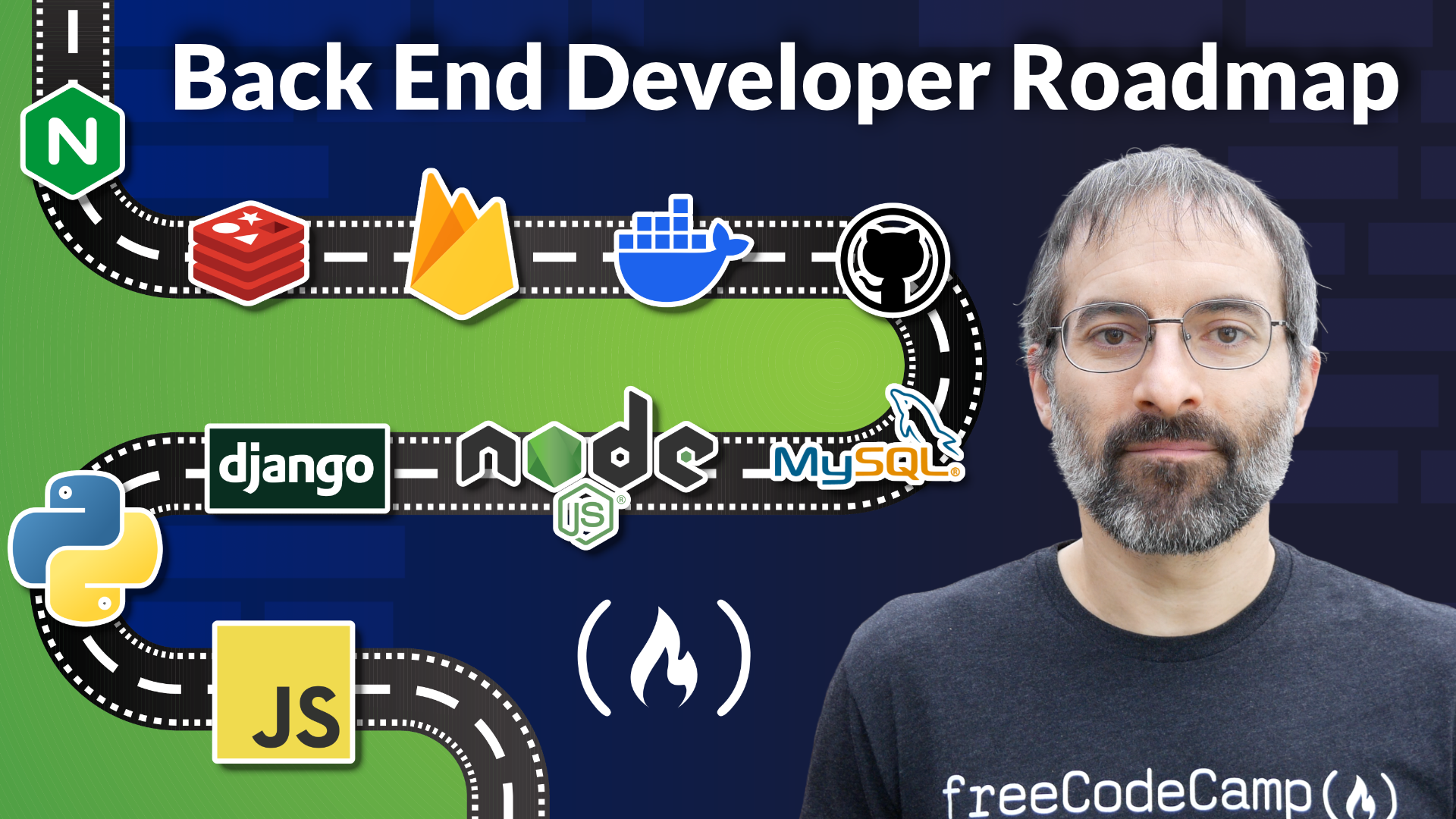Every week we publish a lot of great content on the freeCodeCamp.org YouTube channel. New people sometimes wonder where to start and what order to watch the courses. Well, if you want to become a back end developer, this is where to start.
We just released our back end developer learning path on the freeCodeCamp.org YouTube channel. We’ve curated a collection of top-notch courses on all of the key technologies you need to learn to become a back end developer. An you can watch them free on our channel. The full learning path is over 70 hours long.
In this article, we'll give a brief overview of the technologies you will learn as part of our back end developer learning path.
What is Backend Development?
Backend development involves creating the server-side logic and software that power websites and applications. As a backend developer, you're responsible for writing code that runs on servers, managing databases, developing APIs (Application Programming Interfaces), and ensuring the security and performance of web applications. Your role is crucial in processing user requests, interacting with databases, and managing the flow of data between the server and the client side.
Starting Your Journey in Backend Development
To become a proficient backend developer, a strong foundation in computer science is essential. You'll need to be skilled in server-side programming languages such as Python, Java, JavaScript, Node.js, and .NET. Additionally, expertise in database management using systems like SQL, MySQL, PostgreSQL, or MongoDB is crucial.
As the technology landscape evolves, knowledge in server management, cloud services, and containerization technologies has become increasingly important. Gaining practical experience through personal projects, internships, or contributions to open-source projects can significantly enhance your learning.
Core Technologies and Skills for Backend Developers
Here's a breakdown of the essential technologies and skills that are important to backend development:
Internet Basics
Understanding the basics of the internet is crucial for backend developers. This includes knowledge of how data is transmitted over the internet, the difference between the internet and the World Wide Web, how DNS (Domain Name Systems) work, and the roles of protocols such as HTTP and HTTPS. A solid grasp of these fundamentals allows backend developers to build more efficient and secure applications.
Programming Languages
JavaScript: JavaScript, once confined to the browser, has become one of the most popular languages for backend development, thanks to environments like Node.js. Its asynchronous nature and event-driven model make it suitable for developing scalable and high-performance applications.
Python: Python is renowned for its readability and efficiency, making it an excellent choice for backend development. Its vast ecosystem of libraries and frameworks, such as Django and Flask, allows for rapid development of applications across various domains.
And there are a languages commonly used for backend development such as PHP and Java.
Git and GitHub
Git is a version control system that allows developers to track and manage changes to their codebase. GitHub, a web-based platform, leverages Git, enabling developers to collaborate on projects, review code, and manage changes. Understanding Git and GitHub is essential for backend developers to maintain code integrity and collaborate effectively with others.
Relational Databases
Relational databases store data in tables, which can be linked to each other through relationships. Knowledge of relational database management systems (RDBMS) like MySQL, PostgreSQL, or Oracle is vital for backend developers to design, query, and manage data efficiently, ensuring data integrity and performance.
APIs
Application Programming Interfaces (APIs) allow different software systems to communicate with each other. Backend developers must understand how to create, manage, and document APIs, as they enable the frontend to interact with the backend, fetch data, and perform operations. Knowledge of RESTful services and GraphQL is particularly valuable.
Caching
Caching is a technique to store copies of data in a temporary storage area, which helps in reducing the load on the backend system, decreasing latency, and improving the performance of web applications. Backend developers need to understand where and how to implement caching strategies effectively.
API Security Best Practices
API security is paramount to protect sensitive data and prevent unauthorized access. Backend developers should be familiar with best practices such as implementing authentication, authorization, data encryption, rate limiting, and regular security audits to safeguard the APIs.
Testing
Testing is critical to ensure the reliability and functionality of backend code. Developers should be proficient in various testing methodologies, including unit testing, integration testing, and end-to-end testing, to detect and fix bugs, improve code quality, and enhance the stability of the application.
Software Design and Architecture
Understanding software design and architecture is crucial for creating scalable, maintainable, and efficient backend systems. This includes knowledge of design patterns, architectural styles, and principles that guide the structuring of software systems for better performance and scalability.
Message Brokers
Message brokers like RabbitMQ and Kafka facilitate communication between different parts of an application through a reliable, asynchronous messaging system. They are essential for building distributed systems, enabling decoupling of application components, enhancing scalability, and improving fault tolerance.
Containerization - Docker / Kubernetes
Containerization technologies like Docker and Kubernetes are essential for creating, deploying, and managing applications in an isolated, consistent, and scalable environment. Docker packages applications into containers, while Kubernetes orchestrates these containers, managing their lifecycle across multiple environments.
Web Servers - Nginx
Nginx is a popular web server known for its high performance, stability, and efficient resource usage. Backend developers should understand how to configure Nginx to serve static files, proxy requests, and handle load balancing, which is crucial for building scalable and reliable web applications.
GraphQL
GraphQL is a query language for APIs that allows clients to request exactly the data they need, making it an efficient alternative to traditional REST APIs. Backend developers should understand how to implement GraphQL servers to provide flexible and efficient data access.
MongoDB
MongoDB is a NoSQL database that stores data in flexible, JSON-like documents, allowing for fluid data models and rapid development. It's particularly useful for applications that require scalability, fast querying, and the ability to handle a variety of data types.
Firebase
Firebase provides a comprehensive suite of tools for building web and mobile applications, including real-time databases, authentication, and hosting. It's favored for rapid development and its ability to scale automatically, making it a popular choice for startups and agile projects.
Redis
Redis is an in-memory data structure store used as a database, cache, and message broker. Its high performance and support for various data structures, such as strings, hashes, and lists, make it invaluable for scenarios requiring fast access to data, such as caching.
Infrastructure Knowledge
Understanding the underlying infrastructure is crucial for backend developers. This includes knowledge of servers, networks, cloud services, and how they interconnect to deliver applications. Familiarity with cloud providers like AWS, Azure, or Google Cloud and services like virtual machines, container orchestration, and serverless computing can significantly enhance the efficiency and scalability of applications.
Continual Learning and Engagement
The field of backend development is dynamic, with new technologies emerging and best practices evolving. Staying updated with the latest trends, continuously learning, and engaging with the developer community are vital aspects of a successful career in backend development.
This article and our video series on the FreeCodeCamp.org YouTube channel offer a roadmap to start your journey in backend development. While this is a solid foundation, remember that the field is vast, and there are many more technologies and tools to explore. Engage actively with the developer community, experiment with new tools, and always aim for excellence in your work.
In conclusion, whether you're just starting out or looking to deepen your backend development skills, the resources available on our channel provide a comprehensive pathway to mastering the essential technologies and best practices in the field. So, dive in, start learning, and embark on your journey to becoming a proficient backend developer.

